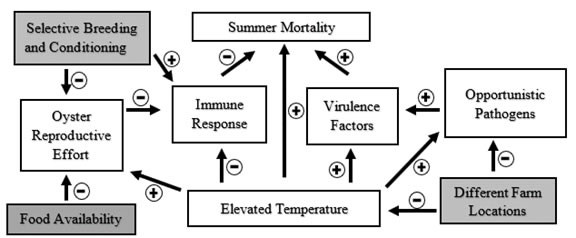Seasonal mortality in Pacific oysters in Baynes Sound: Effect of environmental variables, spawning, and pathogens
17-P-05
Description
Pacific oysters (Crassostrea gigas) have been cultivated in British Columbia for over a century and account for the majority of shellfish cultured in the province. Over the last decade, Pacific oysters in Baynes Sound and throughout the province have been subject to periodic mass mortalities during summer months. In 2016, adult oyster mortality ranged from 50 -90% on intertidal farms and 25 - 100% in suspended culture sites. Juvenile oysters, however, were observed to have negligible mortalities in Baynes Sound or at farm sites on the mainland side of the Strait of Georgia. This trend suggests that reproductive condition of adults may play a possible role in mortality events, as has been reported in other parts of the world. High temperatures, low salinities, harmful algal blooms, low pH, and pathogenic agents have also been factors associated with summer shellfish mortalities. To date, there have been no studies examining the whole suite of factors that might contribute to shellfish mortality on a short temporal scale (e.g. weekly).
This project monitored the following variables within Baynes Sound:
- environmental parameters (i.e., temperature, salinity, and various ocean acidification variables)
- biological parameters (i.e., phytoplankton and zooplankton)
- oyster reproductive state
- bacterial diversity and abundance
- oyster survival at multiple intertidal and deep-water oyster farming sites weekly (May – September)
Following monitoring, the likelihood of each of these factors driving summer mortality events was evaluated.
Findings
In 2017, intertidal-cultured adult oysters were observed at three sites from July 5 - September 15. The cumulative mortality per oyster module correlated significantly with gonad length and the proportion of oysters that were female. Vibrio aestuarianus, a bacterial pathogen of farmed Pacific oysters in France, was found in bacterial cultures from moribund oysters.
In 2018, oysters held in trays at various densities in suspended culture were monitored to characterize the onset of a summer mortality event. The onset of mortality was associated with a period of rapid growth, reproductive development, and elevated temperatures. Cumulative mortality per tray ranged from 34-75%. The highest-density trays had significantly lower mortality, smaller shell width, smaller shell length, and smaller gonad length than those with the lowest density. Histology of oysters during the mortality event showed a mixed microbial infection in gill tissues. Analysis of V. aestuarianus abundance and changes in the microbial community suggest V. aestuarianus was temporally associated with summer mortality.
In summary, oyster mortalities observed in 2017/2018 were associated with elevated water temperatures, increased reproductive effort, and the presence of V. aestuarianus.

Publications
Cowan, M, C Pearce, T Finston, G Meyer, R Marshall, W Evans, T Sutherland, P de la Bastide (in prep.) Assessing the Vibrio community, reproductive effort, and environmental parameters in intertidal Pacific oyster summer mortality in Baynes Sound, Canada.
Cowan, M, C Pearce, T Green, T Finston, G Meyer, B McAmmond, J Van Hamme, E Bottos, R Marshall, W Evans, T Sutherland, P de la Bastide (in prep.) Vibrio aestuarianus, temperature, and stocking density are associated with summer mortality of juvenile Pacific oysters (Crassostrea gigas) in suspended culture.
Cowan, M (2020) Exploring the mechanisms of Pacific oyster summer mortality in Baynes Sound aquaculture. MSc Thesis, University of Victoria, Victoria, British Columbia, 127 pp.
Program name
Aquaculture Collaborative Research and Development Program (ACRDP)
Years
2017-2020
Principal investigator
Chris Pearce, Research Scientist, Fisheries and Oceans Canada, Pacific Biological Station, Pacific Region
E-mail: Chris.Pearce@dfo-mpo.gc.ca
Team member(s)
Malcolm Cowan, MSc Student, University of Victoria
Paul de la Bastide, Research Associate, University of Victoria
Terrie Finston, Research Associate, University of Victoria
Will Hintz, Professor, University of Victoria
Terri Sutherland, Research Scientist, Fisheries and Oceans Canada, West Vancouver Lab, Pacific Region
Collaborator(s)
Eric Bottos, Assistant Professor, Thompson Rivers University
Wiley Evans, Scientist, Hakai Institute
Tim Green, Canada Research Chair, Vancouver Island University
Robert Marshall, Biologist, Mac’s Oysters Ltd.
Breanne McAmmond, MSc Student, Thompson Rivers University
Gary Meyer, Biologist, Fisheries and Oceans Canada, Pacific Biological Station, Pacific Region
Jonathan Van Hamme, Associate Professor, Thompson Rivers University
- Date modified: